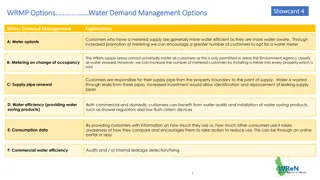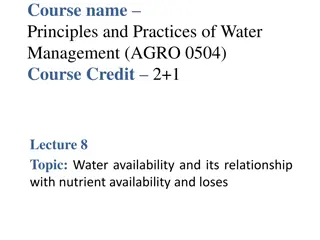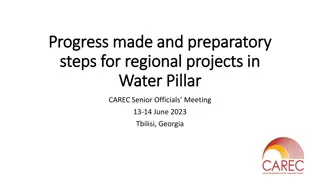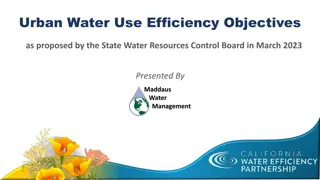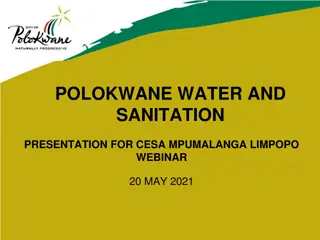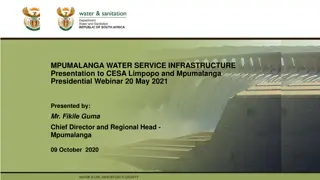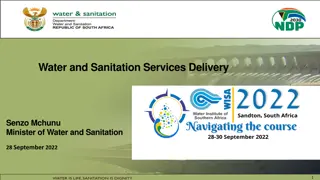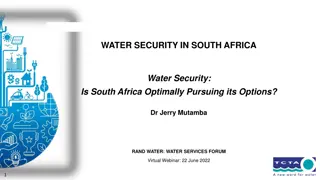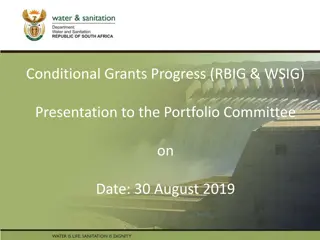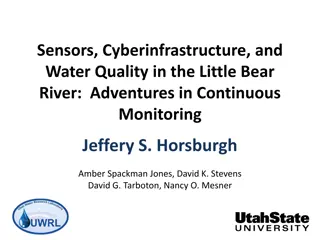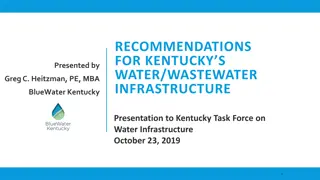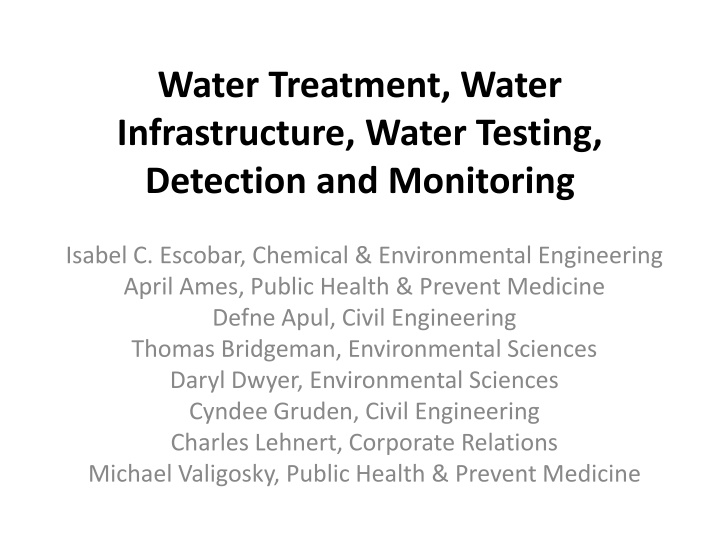
Water Quality Improvement Strategies and Treatment Techniques
This comprehensive overview discusses various water quality improvement strategies and treatment techniques presented by experts in the field. Topics include the use of sedimentation ponds to prevent pollutants from entering natural water bodies, the necessity of employing multiple methods for effective water treatment, and the importance of advanced processes like activated carbon application for toxin removal. The emphasis is on safeguarding water sources through a combination of innovative approaches and established practices.
Download Presentation

Please find below an Image/Link to download the presentation.
The content on the website is provided AS IS for your information and personal use only. It may not be sold, licensed, or shared on other websites without obtaining consent from the author. If you encounter any issues during the download, it is possible that the publisher has removed the file from their server.
You are allowed to download the files provided on this website for personal or commercial use, subject to the condition that they are used lawfully. All files are the property of their respective owners.
The content on the website is provided AS IS for your information and personal use only. It may not be sold, licensed, or shared on other websites without obtaining consent from the author.
E N D
Presentation Transcript
Water Treatment, Water Infrastructure, Water Testing, Detection and Monitoring Isabel C. Escobar, Chemical & Environmental Engineering April Ames, Public Health & Prevent Medicine Defne Apul, Civil Engineering Thomas Bridgeman, Environmental Sciences Daryl Dwyer, Environmental Sciences Cyndee Gruden, Civil Engineering Charles Lehnert, Corporate Relations Michael Valigosky, Public Health & Prevent Medicine
Sedimentation ponds to improve water quality: Daryl Dwyer Sedimentation Pond For preliminary results after 2 months, estimations of the overall improvements in water quality on an annual basis = 10 tons (50 %) of phosphorus prevented from entering Lake Erie and 75 % of E. coli in Wolfe Creek prevented from entering beach waters If scaled to Maumee River watershed this could prevent 1,000 tons (~50 % reduction) of phosphorus from entering Lake Erie which exceeds the target value of 37 % (Phosphorus Task Force II Final Report) For this to be effective in the Maumee River watershed we must implement sedimentation ponds in a variety of locations throughout the watershed Possible Locations for Future Implementation Flatrock Creek, Auglaize, OH Missionary Island, Waterville, OH **Chokepoints
Current Water Treatment Techniques Must use several methods in conjunction to eliminate both cells and toxins Coagulation/flocculation/sedimentation are not enough Activated carbon Final treatment with chlorination Pretreatment with an oxidant will kill the algae and release T&O compounds The algae and T&O compounds can increase DBP production
Polishing Water Treatment: Isabel Escobar The application of activated carbon is one of the most efficient measure for dissolved toxin removal Primary Oxidant + Chlorine Disinfection Cyanotoxin MC-LR CYN Ozone ++ ++ KMnO4 ++ + Chlorine + ++ Oxidation & disinfection: Assessment of the influence of water quality parameters (DOC, alkalinity, pH, temperature, ammonia) on toxin oxidation Need biofiltration to follow ANTX ++ ++ Symbols: Colors: ++effective oxidation of toxins ineffective oxidation of toxins green low DBP risk yellow medium DBP risk red high DBP risk Membrane filtration efficiency (ultrafiltration, nanofiltration, reversed osmosis): Limited information available Algal exopolymer particles (TEP) on a membrane surface
Transport and Fate of Cyanotoxins in Aged Drinking Water Distribution Systems and Building Water Systems Youngwoo Seo Scopes Understand interaction (accumulation and degradation) of cyanotoxins with pipe surface Develop removal methods at the treatment plant or at local water distribution points Develop decontamination protocols with hydraulic and water quality modeling Scaling and bacterial biofilm formation on a corroded pipe Accumulation and potential degradation of cyanotoxinx
Rain Harvesting Systems: Defne Apul
Detection in Water Samples: Joseph Lawrence, Isabel Escobar ELISA immunological assay based on the reaction of all microcystins with antibodies. (Enzyme-Linked ImmunoSorbent Assay) specific Interferences, such as calcium HPLC (High Performance Liquid Chromatography) separates individual microcystin variables by their absorption spectrogram in a photodiode array detector. Interferences, such as humics in surface water




